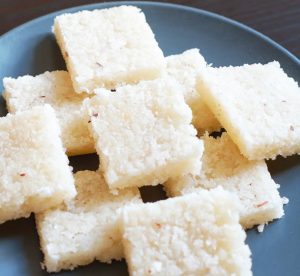Mama’s Punjabi Recipes: Narial Di Burfi (Coconut Milk Squares)
By popular demand from many readers, below is a reprint of Mama’s Narial di Burfi recipe, which is a tasty sweet to make especially during the merry winter holiday season. It is reprinted with some additional information and directions.
Burfi (milk squares) is one of the most common and popular confections in India and is widely available all over the country, in one flavor or the other. It’s a favorite of little kids in particular as they can gobble up the burfi pieces which are cut into squares or diamond shapes. When my kids were little, they would call my younger brother burfi bhapa (burfi uncle) since he would always bring burfi when he would come to see them. That name stuck to him till the kids went through high school!!
And burfi comes in all varieties too, from the plain condensed milk version to the pista (pistachio), badam (almond) or kajju (cashew). It can be plain or with a traditional coating of warak (a very fine film of real silver or gold) or these days coated with a layer of dark chocolate which young kids just adore.
The old-fashioned way to make burfi in traditional halwai’s (confectioner’s) shops is to take whole milk (in India, they use water buffalo milk which is heavy with cream) and let it boil on a stove till it has evaporated down to a thickened layer called khoya. It’s a time consuming process that requires patience, the ability to stand over a hot stove for long hours and continually stir the milk so that it doesn’t stick to the bottom and burn, and. But nowadays franchise stores are mechanized and cut down on the hard labor time by using readymade khoya.
Narial (coconut) are plentiful in India, especially in the tropical coastal regions south of Mumbai and Pondicherry, and have been used in ceremonial havans (religious rites) since time immemorial. Coconuts are versatile and are used in food to cosmetics. A 100 gm serving contains 354 calories and is high in saturated fat and carbohydrates, and coconut water contains 19 calories but no significant nutrients while coconut milk is used to produce virgin coconut oil.
This recipe uses coconut flakes and is a fast way to make a tasty burfi that can match the store made ones. It is quick and easy to make – in about 30 minutes – and those who eat it will never know the difference!
Ingredients:
1 cup non-fat milk powder
1 cup bariq narial (fine coconut flakes)
¼ cup pani (water)
1/2 cup bariq chinni (fine sugar)
1 tbsp doodh (milk) – whole or non-fat per your choice
Coloring to your choice or ¼ tsp haldi (turmeric) for yellow tinge
Directions:
1. Bring the water to a boil, then add the sugar and bring to a second boil for 5 minutes.
2. Pour the coconut flakes in a bowl then slowly add the sweet boiled water and mix thoroughly.
3. Now add in the milk powder and coloring and mix thoroughly again. Knead with your hands till the mixture forms into a ball. Coat your hands with some vegetable oil so that the ball will not stick.
4. Coat a large, clean dinner plate with a thin film of vegetable oil so that the mixture will not stick.
5. Take the ball out the bowl and place on the dinner plate.
6. Use a velna (rolling pin) to spread the ball on the plate into a ½ thick flat pancake.
7. Cover with some wax paper and place the plate in the fridge for an hour.
8. Remove from fridge and then cut the pancake into 1.5 inch square or diamond shapes and serve at room temperature.
MAMA’S TIP OF THE WEEK
WHEN USING GUR (JAGGERY) BREAK INTO LITTLE PIECES FIRST
During the winter months, it is very tempting to make sweets and other snacks that fill the house with wonderful aromas. Also, there are plenty of tid-bits for the family to nibble on. One of these is making gur (jaggery) coated kharot (walnuts), badam (almonds) or pecans, a favorite in Southern USA.
But many inexperienced cooks make the mistake of using the hard block of gur directly into the pot and stirring to make it melts. This takes a lot of time and often will burn the gur which will stick to the pan and will be hard to scrape off.
Always first put the gur in a plastic bag and break it into small pieces with a hammer and then place them into the pot to heat up. The gur will melt faster and your time will not be wasted.

Shakuntla Malhotra is a skilled cook of Punjabi dishes made in the old-fashioned style that she learnt as a young woman in her ancestral home in Lyallpur (since renamed Faisalabad), India before it became part of Pakistan after the Partition in 1947. People have often admired her cooking for its simplicity and taste that comes with each mouthful. Even in her mid-eighties, she continues to cook daily and agreed to share some of her delectable Punjabi recipes

